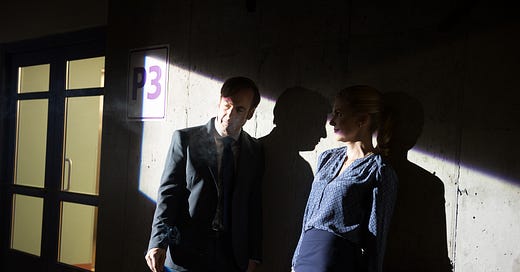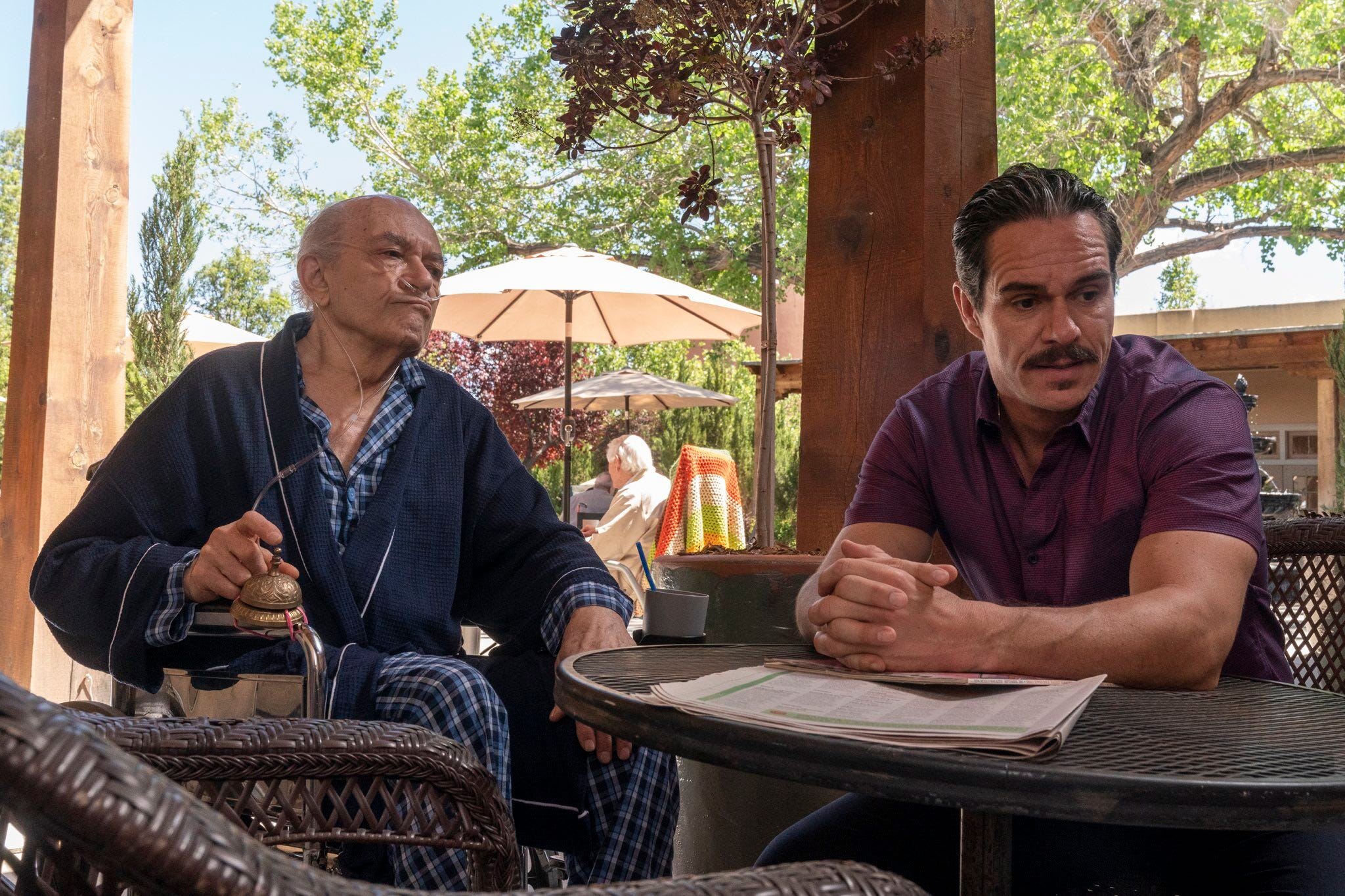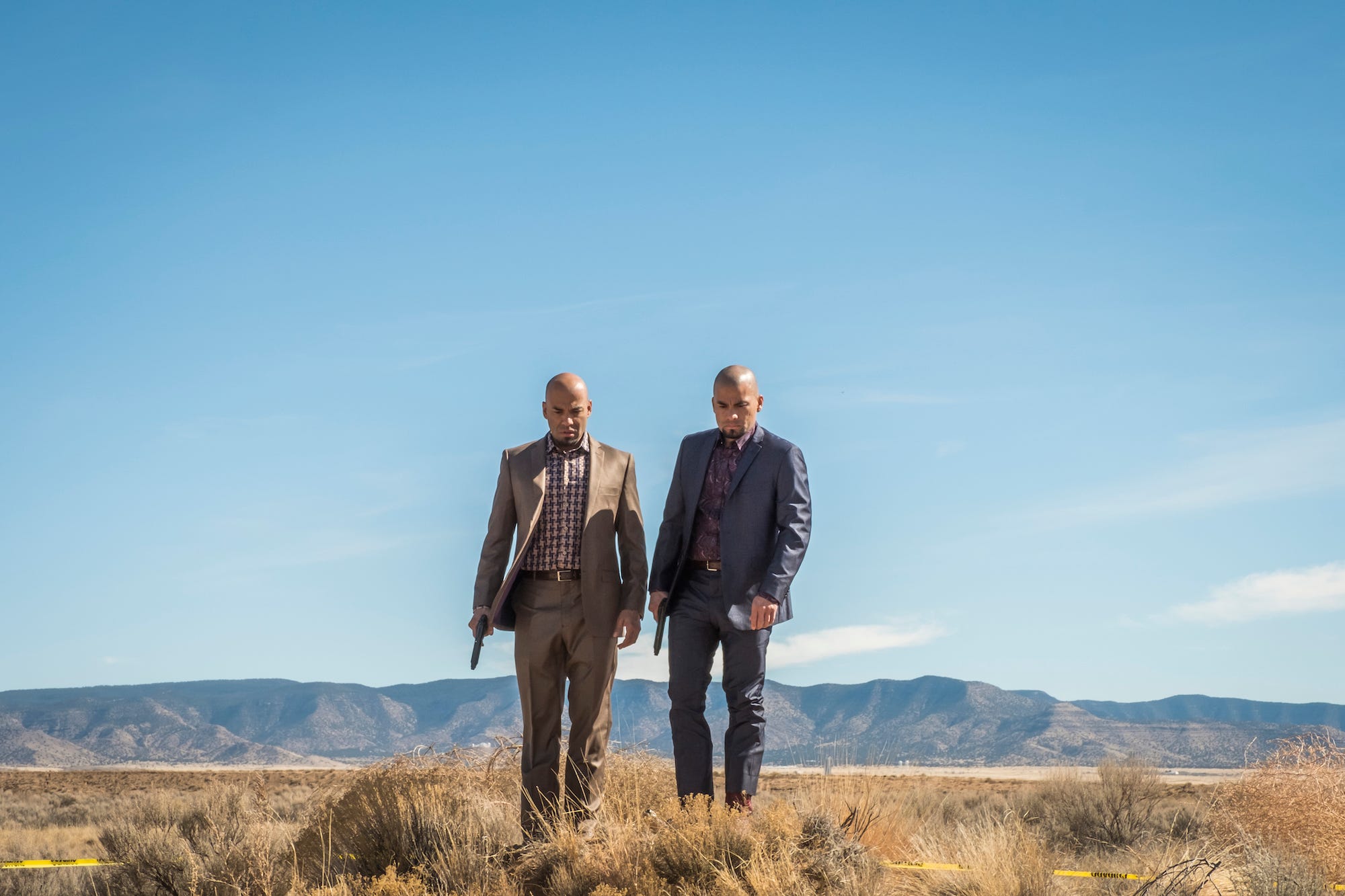On 'Better Call Saul,' the Immigrants Are White Americans
Bad Spanish, Latinos as drug lords, and who gets to decide what's the Best Show of All Time?
My mother’s mother came to the U.S. with two of her daughters in search of a better life but also to shed the scars of her old one. What those scars were, I don’t think I’ll ever know. They’ve been hinted at, speculated on by my mother to me in hushed conversations—but never questioned. It was the 1960s. She was a young woman in her mid-twenties and worked odd jobs for years to make ends meet: caretaking, making shoes in a factory, cleaning hotel rooms. Six years later, my father’s parents would do the same.
It’s a story you’ve likely heard before. Immigrants moving to New York City in hopes of prosperity, fumbling their way through it till eventually they find their people. Even when they do, it’s not easy.
On Better Call Saul, the immigrants are Americans who move from other states to Albuquerque, New Mexico.
Jimmy McGill (Bob Odenkirk), also known as the eponymous Saul Goodman, is a real bastard, a hustler. After running one too many hustles in Chicago, he winds up in jail. His brother pulls off a miracle to get him out. Knowing this is his last chance, Jimmy flees Illinois in pursuit of bettering himself in Albuquerque.
He works the mailroom at his brother’s law firm, finding love or something like it with Kim Wexler (Rhea Seahorn). They both go to law school, Jimmy in secret, and become lawyers themselves.
The thing is Kim also fled to Albuquerque. She grew up poor in Nebraska with an alcoholic, neglectful mother. In her words, she wanted to do big things and there were limited options in her hometown.
The main cast is rounded out by Mike Ehrmantraut (Jonathan Banks), a Marine veteran and an ex-cop. His son, also a cop but not dirty like Mike, was killed by two of his coworkers in fear that he’d out them all for being corrupt. Mike avenged his son’s death, leaving Philadelphia the moment right after he kills his son’s killers. He, too, winds up in Albuquerque, to flee the grief he cannot overcome or the cops who will surely suspect him of murder or both.
It might go without saying but I’ll say it. These three main characters are non-Latino white. They’re transplants to “New” Mexico. Eventually, they find themselves caught in the dangerous world of the Mexican drug cartel, the danger sneaking upon their lives being Latinos. They stumble their way into this world partly because of bad luck, partly because these are the people they’ve always been.
Throughout its run, the show introduces a bevy of characters. The non-Latino white characters are allowed to be other lawyers, paralegals, assistants, defendants, cashiers. With one or two notable exceptions, the Latinos are only part of the cartel: they’re drug lords, drug dealers, henchmen. If it’s not that, then they’re silent and off to the side. Have you met our new junior associate, Amy Hernandez, the extra standing next to me who has no lines?
The Latino world expands only through the cartel. We begin with Tuco Salamanca (Raymond Cruz), then Nacho Varga (Michael Mando), then it’s Hector Salamanca (Mark Margolis) and Gustavo Fring (Giancarlo Esposito) and Don Eladio (Steven Bauer). While the white world and the Latino world intermingle from time to time, one of the show’s quirks is how separate they often seem. Mike moves within the drug/Latino storylines with ease, but often watching the show feels like watching three separate universes—Jimmy’s, Mike’s, and Nacho’s. That is until Nacho or Lalo Salamanca (Tony Dalton) asks Jimmy for a “favor.” Then, the score tenses up and Jimmy gulps nervously; despite his shenanigans and questionable ethics, he’s in real trouble now.
If you ask most people, the show is one of the best of all time—the tension, the stakes. If you ask me, I think it’s still up for debate, but isn’t it always? In seasons one through four, the tensest moments come from drug lords and dealers speaking to each other, their hands close to grabbing their guns. They speak in Spanish—or at least they try, which is the problem. They simply cannot, even though we are to believe they’re fluent or native speakers. The result is worse than Robert Rubenstein saying “quiero ser su abogado.” These scenes are supposed to be nerve-wracking, but instead they’re funny enough to make you laugh. Unless you don’t speak Spanish, of course.
I want to be clear: Most of the characters on Better Call Saul are not good people, and what I’m after isn’t Latino characters who are saints. I do wonder, however, if a show’s goal was to make the audience feel nervous or fear for what’s coming next, but what they actually accomplished was making this viewer laugh, did they do what they set out to do? If the characters are supposed to speak Spanish fluently, but the actors clearly can’t, am I supposed to ignore that I can’t suspend disbelief? If the Albuquerque population is almost 50 percent Latino, should I assume they’re all in the drug business?
I’ve been enjoying the show much more in seasons five and six. It’s no wonder why. The aforementioned universes have begun to converge, yes. But the show has eschewed its bad-Spanish problem. It silenced Hector Salamanca. It’s kept Gustavo Fring’s Spanish scenes to a minimum. It brought in Lalo. That said, it seems the show has tapped out on adding any new characters (the final episodes premiere later this summer). Having watched most of the show in just the past month, it feels like a bizarro version of the Latino immigrant stories you’ve heard in the past. These white Americans flee their old states to better their lives and leave their scarred past, but soon find themselves as fish out of water, entrenched in this nefarious Latino drug cartel.
Latinos involved in cartels and gangs on TV shows is nothing new. In fact, it’s almost a prerequisite if you want to throw a Latino character into your show’s cast. You’ve seen it before. They’ve got tattoos and wear rosaries and their mothers have a framed photos of Jesus in their house or maybe a statue of the Virgin Mary. They drive flamboyant cars. Whenever they’re on screen, reggaeton plays in the background.
That’s prosaic, though it is disappointing that we continue to canonize TV shows as The Best of All Time when they play within the same, tired stereotypes.
When I’ve brought up similar thoughts thrice before, I’ve been met with the same rebuttal: “To be fair, the same can be said about Breaking Bad.” It’s a way to shut the conversation down. Breaking Bad is the greatest television show of all time, you see. It’s above criticism. Better Call Saul is its prequel, equally as good, and if we didn’t see it as a negative about Breaking Bad then it’s hardly a negative about Better Call Saul.
But I disagree. Breaking Bad started in 2008. It might not seem like too long ago, but we weren’t having as open conversations about the portrayals of marginalized characters on TV then as we’re having today. More importantly, it’s a reminder of something we already know: the majority of critics are white. When I think about what’s canonized as Great Television, I think about who’s doing the canonizing. On some days, I, too, think Breaking Bad is the best show of all time. Some other days I think it’s The Americans or The Good Wife or Seinfeld or The Simpsons or even Jane the Virgin (if I’m feeling mischievous, I’ll tell people it’s Riverdale). This is a thought that doesn’t exactly keep me up at night, but it does often scratch the folds of my brain. Film is so young, and television even younger. We can’t see or appreciate it now, but like all art, criticism and the people we value to make it will determine how the shows airing today go down in history. The chosen few on Rotten Tomatoes will help define what this piece of art means.
The creator of Breaking Bad, Vince Gilligan, once said he pitched the show as “You take Mr. Chips and turn him into Scarface.” And it is true that the same criticism I have here about Better Call Saul can be said about Breaking Bad. Walter White starts as a timid high school teacher. Before the first episode, he and his straight-laced, white family would never consider something as nefarious as making drugs or selling them. As he continues to break bad, he’s met with a series of villains, most of them being Latinos. Each victory against them inflates his ego, like he’s a video game character leveling up. (The same scenes with badly spoken Spanish also apply.) That’s a reductive way of explaining it. The show is brilliant. But I do find myself questioning that blanket statement more these days. With Saul and Bad, the white protagonists exists both in and outside of Albuquerque, New Mexico. Their timidness, their fish-out-of-water-ness, is linked to their whiteness, if only because both series, but especially Better Call Saul, refuse to introduce Latino characters who aren’t part of the cartel, even in a setting that’s half Latino. As they intrude the cartel world, accidentally or willingly, they find it intoxicating, their god complexes growing bigger. “I am the one who knocks,” Walter White says. “Lightning bolts shoot from my fingertips,” Jimmy McGill yells. How else do you take Mr. Chipping, an austere yet cherished white man, and turn him into Tony Montana, a heinous Latino?
The shows are brilliant. We could list the ways. Top of mind is the methodical character work. But that work, that descent, is done by intruding more and more in non-white spaces. Of course, this seems normal because it is the norm. It’s what we’ve been conditioned to see and expect. It’s also the interesting version of the story here: The white protagonists, and even some of the supporting white characters, have farther to fall because they aren’t vile to start. They’re afforded the benefit of transformation by stepping into that “other” world of Albuquerque, even if they’re the ones who encroached upon that space by migrating there, even if that othering doesn’t match with reality. The Latinos, however, are already at rockbottom. That’s a forgone conclusion. The white characters are allowed to break bad; the Latinos have already broken it.
Criticizing The Best Thing Of All Time, even if it’s Breaking Bad, shouldn’t feel like a radical action, and yet to do so is to walk on eggshells. With new information and an influx of new points of view, it’s healthy to redefine the way we see a TV show, even if it’s beloved. If you don’t speak Spanish, of course you’d find the Spanish-speaking scenes to be anxiety-inducing. If you’re not Latino, it’s not a surprise you’d forgive or even be blind to how the Latino characters are used to prop up the main, white character’s development—his descent. If the majority of critics we’ve deigned as having Good Opinions don’t speak Spanish and aren’t Latino, then naturally these critiques don’t enter the mainstream consciousness.
And if you can speak Spanish or you are Latino, even if you’re a critic, then it’s easy to dismiss them altogether anyway. There are so many roles for Latinos on this show, it can be easy to mistake it for good representation or to turn a blind eye. It’s on a prestigious television show; the critics have said so. Crumbs fill you up like a four-course meal when you’ve been starving.
Latinos make up a fifth of the U.S. population but less than a tenth of the characters on TV and barely above 7 percent of leading roles.
I love Breaking Bad. And don’t misunderstand, I don’t dislike Better Call Saul. I like it quite a bit. I’ve been watching it almost nonstop for a few weeks now. It’s good. It’s made with confidence. Its emotional beats always feel earned. Watching its characters fall further has been both addicting and heartbreaking.
It’s tough to explain the complexities of opposing thoughts in my mind when it comes to TV shows like this, mostly because some people don’t understand how you can love a show and criticize it at the same time. In fact, it is often the shows I love or whose brilliance I recognize most that I criticize more.
Maybe it shouldn’t be this way, but compartmentalizing what a show achieves in terms of storytelling apart from how it awkwardly navigates sociopolitical issues, particularly Latino ones, is par for the course for a viewer like me. Otherwise, how would we watch anything? I’ve had a lot of practice. Shutting off the part of my brain that sees these inadequacies and wishes we were doing a bit better, especially on a show most are deeming the best? That’s easy. After all, when it comes to watching television, I’ve had to do it my whole life.





